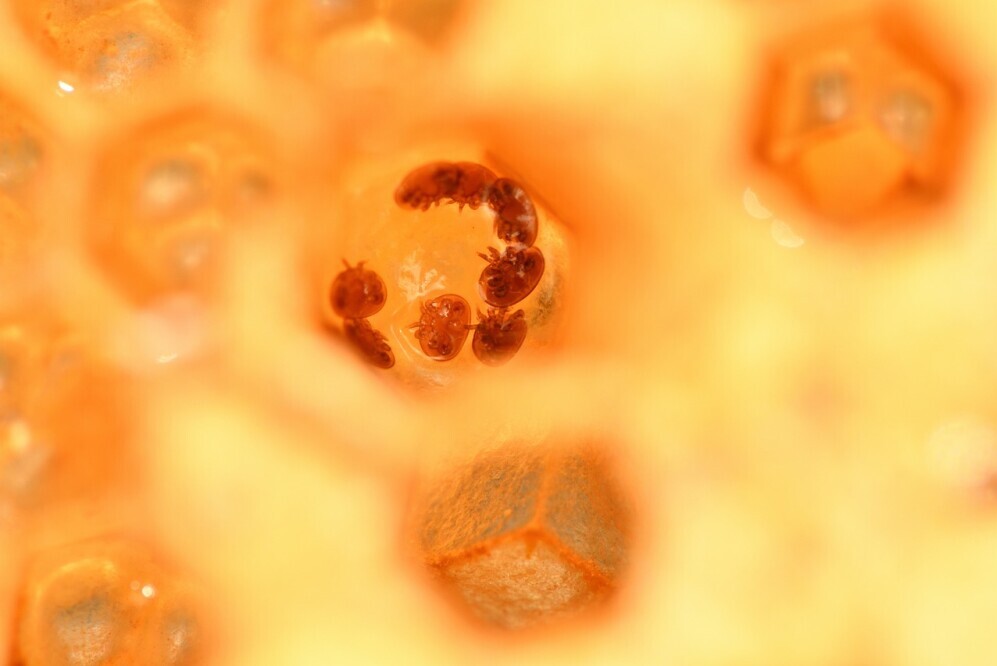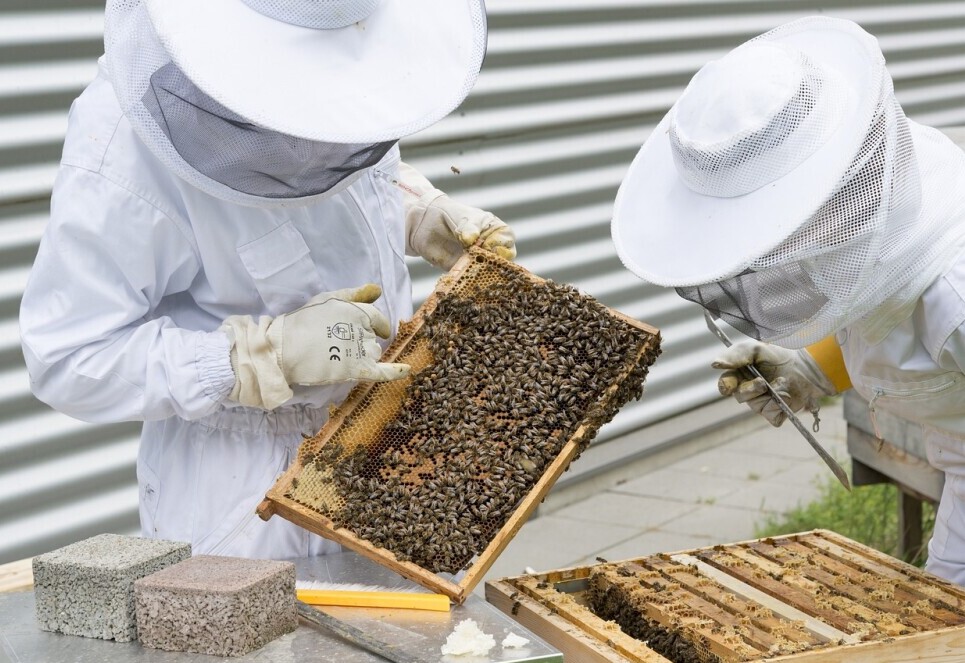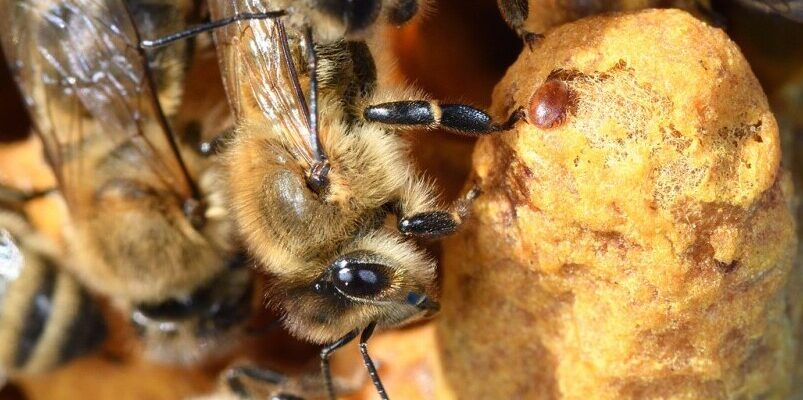Varroa mites, officially known as Varroa destructor, are tiny parasites that pose a massive threat to honeybee colonies. Imagine a tick the size of a dinner plate hitching a ride on you, constantly feeding on your vital fluids. That’s how these mites affect bees.
These pests latch onto bees, feeding off their fat bodies and weakening them over time. This feeding creates open wounds, making bees more susceptible to viruses and diseases. Consequently, their presence is nothing short of a nightmare for those tending to beehives.
Understanding their lifecycle is crucial for any beekeeper. From eggs to full-fledged adult mites, these parasites live most of their lives hidden under the protective cap of developing bee brood. This clever disguise makes them slippery enemies to pinpoint.
With a knack for rapid reproduction, Varroa mites thrive in modern apiaries. They spread like wildfire, moving from hive to hive with little effort. So, spotting early signs of infection becomes vital to preventing these hitchhikers from taking over the colony.
As a beekeeper, one of the first battles you’ll face is recognizing the symptoms of an infestation. Watch out for bees with deformed wings or a dwindling colony. Addressing these signs quickly can mean the difference between a flourishing apiary and empty hive boxes.
The Lifecycle of Varroa Mites: Understanding the Enemy
Varroa mites lead a covert yet dramatic life, intricately entwined with honeybee colonies. Knowing their lifecycle isn’t just about battling them—it’s about predicting their moves and outsmarting them.
These mites start their life as tiny, oval-shaped eggs laid within the cell of budding honeybee brood. The protected environment of the capped brood cell serves as their incubation chamber. The mother mite lays several eggs, and upon hatching, the young mites feed directly on the pupating bee, growing stronger with each meal.

The lifecycle pacing is no accident. It syncs precisely with the bee’s own development, allowing adult mites to emerge just as young bees hatch. This timing helps adult female mites hitch a ride out into the colony, ready to reproduce again or jump to new hosts, like hapless bees in nearby hives.
Varroa mites primarily target drone brood, drawn by the longer development period. This allows them more time to reproduce, amplifying their numbers exponentially. But when numbers run high, they don’t shy away from worker brood either, making them even more hazardous.
Seasonal changes add another wrinkle. Spring and summer, with their active brood production, trigger mite population booms. As bee activity dips in fall and winter, so too does mite reproduction, but the damage by then is often done. Recognizing these cycles helps in planning timely counter-strategies.
The reality is that Varroa’s resilience and reproductive cunning make them formidable adversaries. Keeping a close watch on these seasonal patterns is key to maintaining a balance between colony health and mite control.
Impact of Varroa Mites on Honeybee Colonies
The presence of Varroa mites within a honeybee colony can have devastating effects. These tiny parasites wreak havoc, not just through direct damage, but also by setting the stage for widespread issues that can topple entire hives.
The most immediate impact is on individual bee health. As Varroa mites feed, they compromise the bees’ ability to fend off infections. This opens the door to a host of pathogens, most notably the deadly Deformed Wing Virus, which leaves bees unable to fly and effectively work.
It’s not just individual bees feeling the pinch. The entire colony suffers as worker bees, essential for all hive activities, have reduced lifespans. Their weakened performances translate to lower productivity, affecting honey yields and overall colony strength.

In the larger scheme, a heavy mite burden can lead to the phenomenon known as colony collapse disorder (CCD). Though several factors are at play in CCD, Varroa mites are often significant contributors. They drain the colony’s vigor, making it less resilient against other threats like pesticides and environmental changes.
Beyond just beekeeping, the implications of Varroa infestation ripple into agriculture and food production globally. Honeybees are crucial pollinators, and their demise directly impacts crop yields. This ties the battle against Varroa mites not just to hobbyists but to food security worldwide.
Protecting bees from Varroa’s impact is about more than just keeping a few hives alive. It’s about preserving an intricate part of our ecosystem and supporting the very foundation of agricultural systems. For beekeepers, understanding these impacts guides them in crafting strategies that safeguard both their colonies and the broader environment.
Detection Techniques: Spotting Varroa Mite Infestations Early
Early detection of Varroa mites is crucial for maintaining healthy bee colonies. The faster you identify an infestation, the quicker you can take action—saving time, effort, and countless bees.
Beekeepers have a variety of techniques at their disposal. Visual inspections are a good starting point. Checking bee brood and adult bees for visible mites can sometimes give you a direct indication of infestation, even if it requires a keen eye and a bit of patience. However, by the time you spot varroa mites, the population is already high.
For more thorough checks, sticky boards are a popular choice. Placed at the bottom of a hive, these boards catch mites dropping off bees, giving you a reasonable estimate of how bad the infestation might be. It’s an easy, hands-off method, though it might require a steady supply of boards and some diligent counting. However, the results still aren’t very accurate.

Another go-to is the sugar shake method. This involves coating bees with powdered sugar, causing mites to drop off when shaken into a container. After a quick stir, you can count the mites at the bottom to gauge the infestation level. It’s gentle on the bees and can be done with minimal equipment.
Then there’s the alcohol wash—a bit more hands-on and, unfortunately, lethal for the sampled bees. It involves submerging bees in alcohol to dislodge the mites for easier counting. This method is highly effective in providing accurate infestation data.
Technological advances keep pushing the envelope in mite detection, offering tools like electronic sensors and apps designed to track mite populations more precisely. While still emerging, these innovations hold promise for future-proofing beekeeping against Varroa mites.
Whatever your chosen method, regular checks are key. They ensure that you stay on top of Varroa activity and make timely decisions to protect your colonies, maximizing both their health and productivity.
Mitigation Strategies: Battling Varroa Mites Effectively
Fighting Varroa mites is a mix of art and science. While the battle is tough, understanding your options can turn the tide in your favor.
Chemical treatments often come first to mind for beekeepers. Products like miticides can be effective, but it’s important to use them wisely. Overuse or incorrect application can lead to mite resistance or even harm your bees. Always stick to recommended guidelines and timing to minimize any negative effects.
Embracing Integrated Pest Management (IPM) combines multiple strategies, both chemical and non-chemical, into a cohesive plan. IPM focuses on monitoring mite levels, using treatments only when necessary, and constantly adapting strategies to the current situation in the hive. This flexible approach helps preserve hive health and sustainability in the long run.

Real-world examples often provide the best lessons. Many successful beekeepers have shared stories of thriving colonies despite Varroa’s presence by using a mix of these strategies. Studying these cases can inspire new ways to adapt and personalize your approach to dealing with these relentless pests.
Ultimately, successful mite control isn’t just about picking the right product or method. It’s about understanding your bees and their environment, being proactive, and continuously learning from your experiences and others’. Each colony is unique, so tailor your strategies to best support the buzzing community you’re nurturing.
Advancements in Varroa Mite Research: Hope for the Future
New developments in Varroa mite research offer some promising prospects for beekeepers. Scientists worldwide are pooling efforts to find innovative solutions, aiming for a future where bees and Varroa mites can coexist with minimal impact.
Genetic research is making headway with breeding programs geared towards developing mite-resistant honeybee strains. These bees can tolerate mites, either by grooming them off effectively or developing resistance to the viruses transmitted by the mites. It’s an exciting area that could shift the landscape of beekeeping.

Technology also plays a pivotal role in the fight against Varroa. Advances in sensor technology and data analytics enable more precise monitoring of mite populations, transforming how beekeepers manage their hives. A hive that’s well-monitored is one that’s better protected.
Globally, collaborative projects are pushing forward knowledge and strategies. Tools like online platforms and global databases allow the sharing of research findings, helping beekeepers across the world to access and implement the latest strategies.
Long-term sustainability in managing Varroa mites involves continued research and adaptation. By staying informed about these advancements, beekeepers can adopt new practices as they emerge, ensuring that their bees have the best chance at thriving in a world where Varroa mites exist. It’s a dynamic frontier, and staying ahead of it is key.

4 comments on “Understanding Varroa Mites: A Beekeeper’s Worst Enemy”
Chris Towers
November 7, 2024 at 12:28 pmThis was a really interesting read for me. I had no idea Varroa mites were such a threat to honeybees.
Some years ago, I used to live next door to a beekeeper (at least I think that he thought he was), and while my experiences with bees were more fearful (I got stung more than once, as did my wife), I never heard about these mites or how they can devastate colonies.
At one point, the loft in a rental house I was living in got completely overrun with bees and I had to call for professional help to deal with it, and I often wondered if it was due to mismanagement from the house next door or just bad luck.
Thanks for offering the information here on these challenges. It’s definitely given me a better appreciation of the things you need to think about when beekeeping and why proper care is so essential.
Much appreciated
Chris
Randi
November 7, 2024 at 5:22 pmThanks for sharing, Chris! Varroa mites are definitely one of the biggest challenges for beekeepers. It’s wild how something so small can have such a big impact! It sounds like you had quite the adventure with bees—sorry to hear about those stings! As far as the bees in the loft, they will often swarm or split their hive as a way of reproducing. It isn’t always an easy thing to catch as a beekeeper. Glad the info gave you some insight into the importance of care in beekeeping!
Chris Towers
November 8, 2024 at 7:04 amThank you for getting back to me Randi!
I appreciate the extra info about swarming and hive splitting. Of course I had no idea it was part of their natural behavior. It was good to learn how delicate the process of beekeeping can be.
Thanks again for sharing your knowledge!
Chris
Randi
November 10, 2024 at 4:33 amAbsolutely! Thank you, Chris for your response!